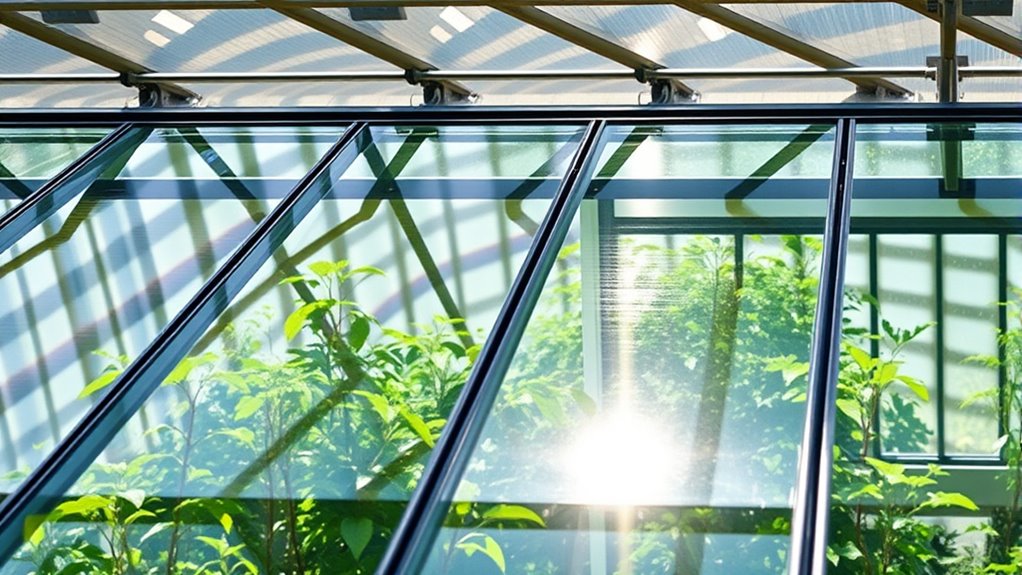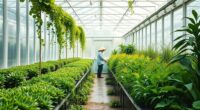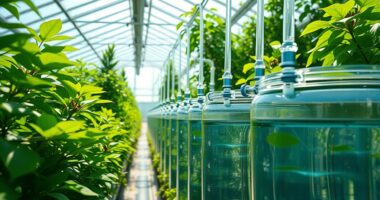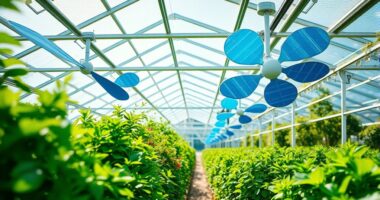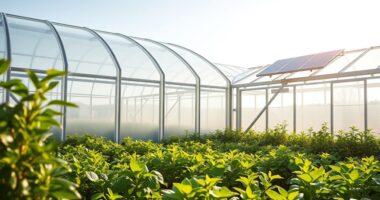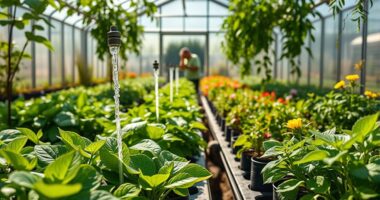Integrating solar panels into your greenhouse roofing allows you to generate renewable energy while preserving ideal growing conditions. Modern, semi-transparent or low-profile panels are designed to maximize sunlight transmission and act as insulation, helping you regulate internal temperatures. Proper placement and angles ensure efficient energy capture without blocking essential light for your plants. This setup can reduce energy costs and create a stable environment, and if you keep exploring, you’ll discover practical strategies for effective integration.
Key Takeaways
- Select suitable solar panel types like semi-transparent or low-profile panels to allow optimal sunlight for plant growth.
- Properly position and angle panels to maximize solar exposure while minimizing shading on crops.
- Use panels as insulation to regulate internal greenhouse temperatures during seasonal changes.
- Ensure panels are weather-resistant and durable for long-term performance in humid greenhouse environments.
- Balance energy generation with plant needs by integrating shading and insulation functions into the design.
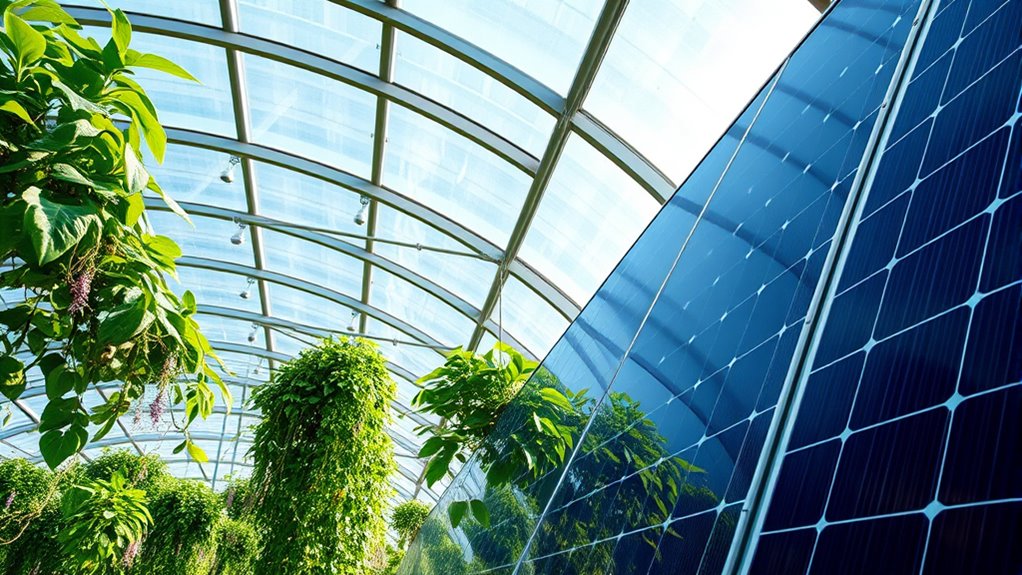
Integrating solar panels into greenhouse roofing offers a smart way to generate renewable energy while maintaining ideal growing conditions. When you carefully consider solar panel efficiency, you ensure that your investment maximizes energy output without compromising the greenhouse’s environment. Modern solar panels are more efficient than ever, capturing a broader spectrum of sunlight and converting it into electricity at higher rates. This means you can produce enough power to sustain various operations within your greenhouse, reducing reliance on external energy sources and lowering operational costs. Additionally, the placement and angle of your panels are essential; optimizing these factors allows for maximum solar exposure and efficiency throughout the year, regardless of seasonal changes.
However, integrating solar panels isn’t just about energy generation—it’s also about preserving the internal climate of your greenhouse. Greenhouse insulation plays a critical role here. When you install solar panels thoughtfully, they can serve as an additional layer of insulation, helping to regulate internal temperatures. This is especially beneficial during cold months, where the panels can act as a barrier against heat loss, keeping your plants warmer and reducing the need for extra heating. Conversely, during hot summer days, properly designed panels can shade the roof, mitigating excessive heat gain and lowering cooling demands. This dual function enhances the overall insulation of your greenhouse, creating a more stable environment for your crops year-round.
To maximize these benefits, you should choose solar panels that are designed for integration into greenhouse roofing. Some panels are semi-transparent or have a lower profile, allowing light to pass through while still generating electricity. This ensures your plants receive enough sunlight for photosynthesis, which is critical for healthy growth. When installed at the right angle and spacing, these panels don’t block essential sunlight but still perform their energy-generating role effectively. Their presence can also help reduce internal temperature fluctuations, making your greenhouse more energy-efficient and easier to manage. Moreover, selecting eco-friendly options like reusable or sustainable materials can further enhance the environmental benefits of your solar installation.
Furthermore, considering the durability and weather resistance of your solar panels ensures long-term performance. Greenhouse environments can be humid and variable, so selecting panels with robust insulation properties and weatherproofing helps maintain consistent efficiency. When your solar system is well-integrated, you’ll notice a more controlled environment, lower energy costs, and a sustainable way to grow your crops. Thoughtful integration allows you to harness the sun’s power without sacrificing the ideal growing conditions your plants need, making your greenhouse both more productive and environmentally friendly.
Frequently Asked Questions
What Are the Long-Term Maintenance Costs for Solar-Integrated Greenhouses?
You’ll find that long-term maintenance costs for solar-integrated greenhouses are generally manageable. Conducting a thorough cost analysis helps you anticipate expenses, while warranty considerations ensure you’re protected against unexpected repairs. Typically, routine inspections and cleaning are needed, but major repairs are rare if the system is well-installed and maintained. Investing in quality panels and understanding warranty coverage can notably reduce your ongoing costs and keep your greenhouse operating efficiently for years.
How Do Solar Panels Affect Greenhouse Humidity and Airflow?
Solar panels can influence your greenhouse’s humidity control and airflow dynamics. They may block some natural airflow or reduce heat exchange, so you’ll need to monitor humidity levels closely. Proper ventilation systems become vital to maintain ideal conditions. By adjusting fans or vents, you can guarantee airflow remains balanced, preventing excess humidity or dryness. This way, solar panels won’t hinder your greenhouse’s environment or plant health.
Can Existing Greenhouses Be Retrofitted With Solar Panels Effectively?
You can definitely retrofit your greenhouse with solar panels effectively. Nearly 80% of existing structures have been successfully upgraded with minimal disruption. Modern solar panel durability ensures they withstand weather, and they can improve greenhouse insulation by shading or reflecting heat. Proper planning maximizes energy generation without compromising airflow or humidity, making retrofitting a smart, sustainable choice for your greenhouse.
What Are the Most Cost-Effective Solar Panel Types for Greenhouses?
You should consider monocrystalline solar panels for your greenhouse due to their high efficiency and better cost comparison over polycrystalline options. They may have a higher upfront cost but generate more energy, reducing long-term expenses. Installation challenges are minimal with proper planning, making them a cost-effective choice. Keep in mind that balancing initial costs with energy output is key to maximizing your investment in solar technology.
How Do Seasonal Changes Impact Solar Energy Generation in Greenhouses?
Seasonal changes gently influence your solar energy generation, as weather variability can diminish sunlight during shorter days and cloudy periods. You might notice a dip in power production in winter while summer offers brighter, more consistent sunlight. To keep energy flowing, consider energy storage solutions, which help balance fluctuations and guarantee your greenhouse remains powered efficiently year-round. Embracing these seasonal shifts allows you to optimize your solar setup wisely.
Conclusion
By integrating solar panels into your greenhouse roofing, you not only generate clean energy but also optimize space and efficiency. This innovative approach can transform your greenhouse into a sustainable, self-sufficient environment. Isn’t it worth considering how such integration could revolutionize your gardening or farming practices? Embracing this technology allows you to cultivate growth while reducing your carbon footprint—making your greenhouse a model of eco-friendly innovation.
